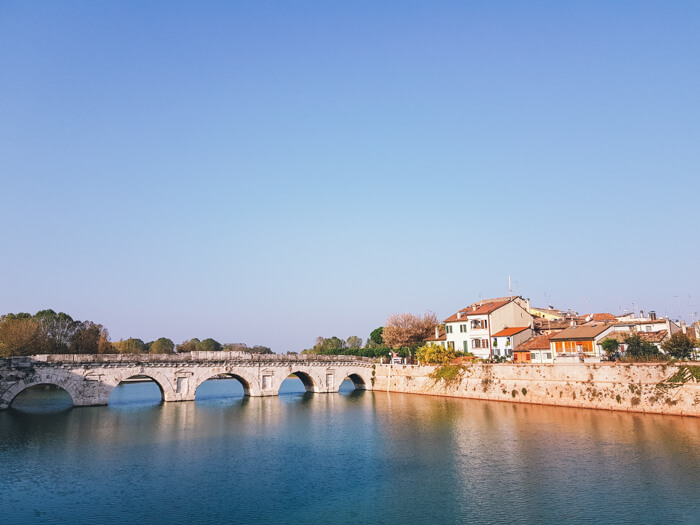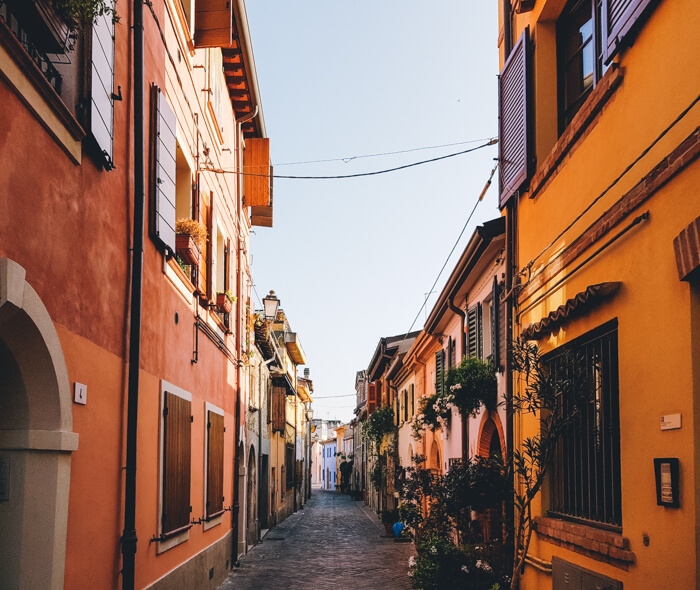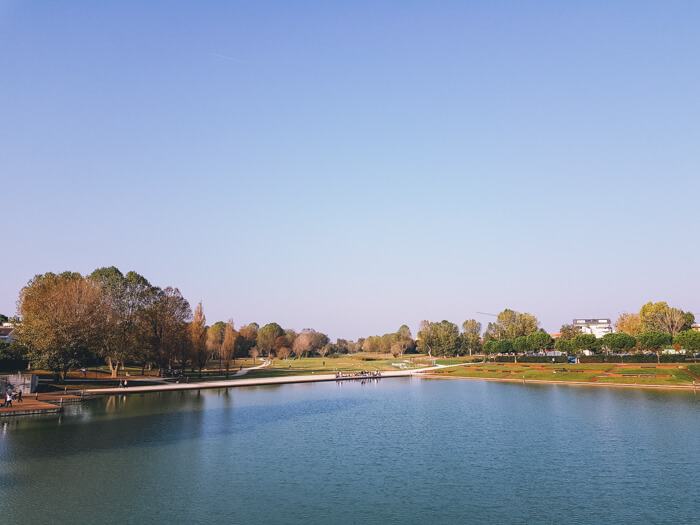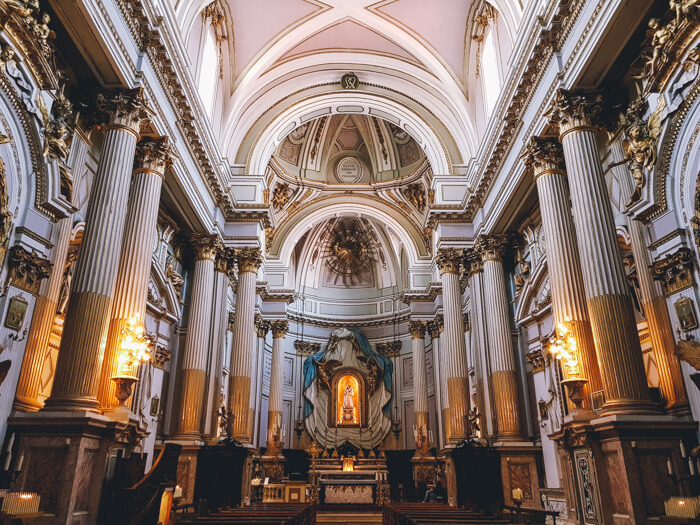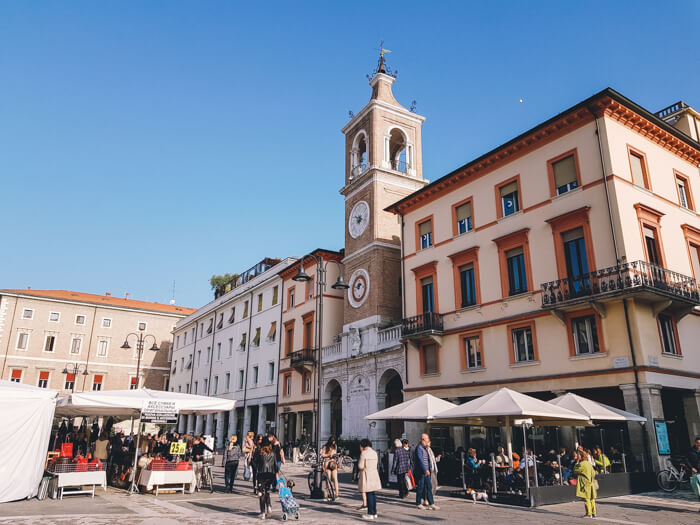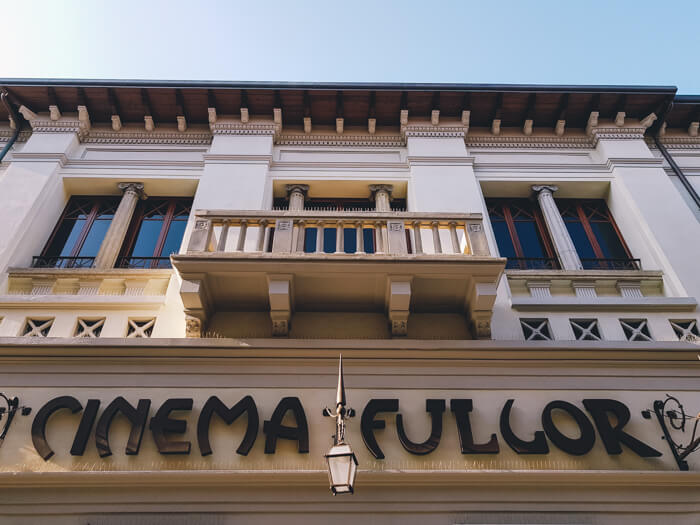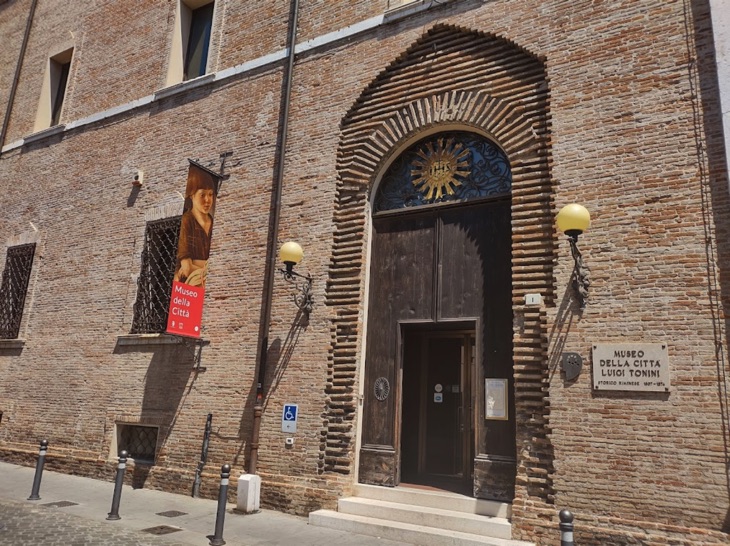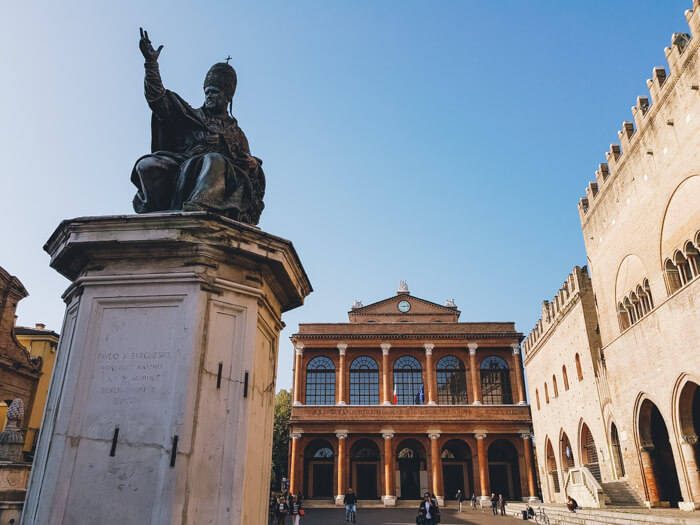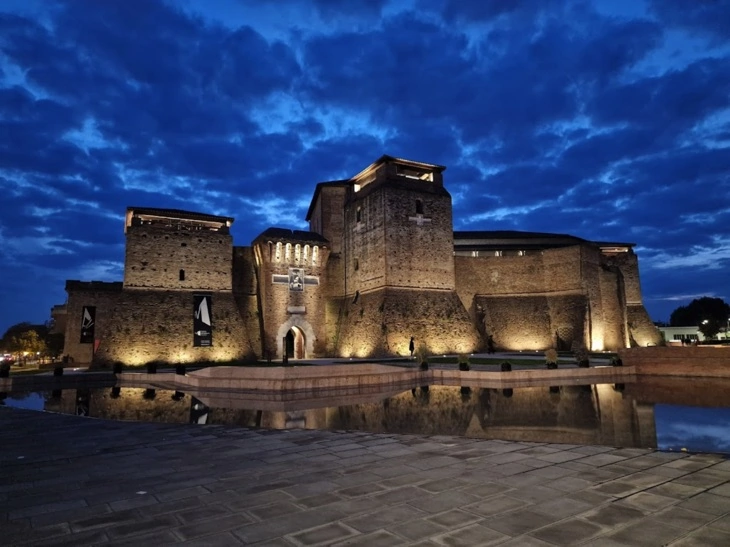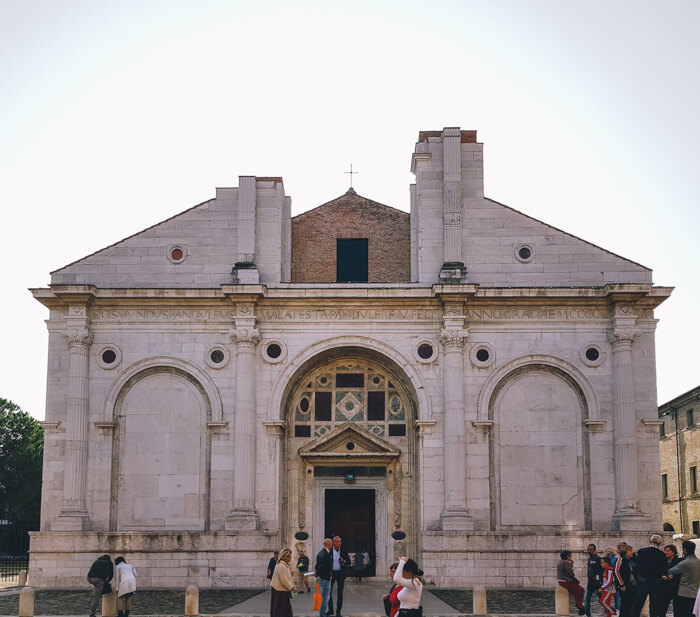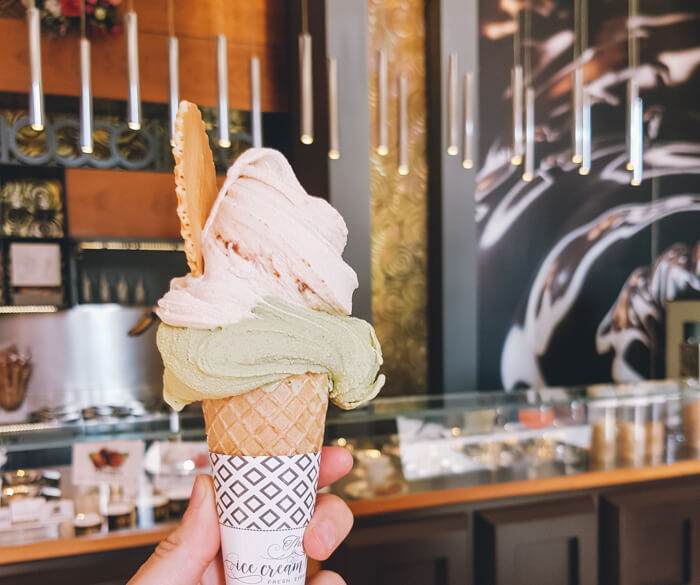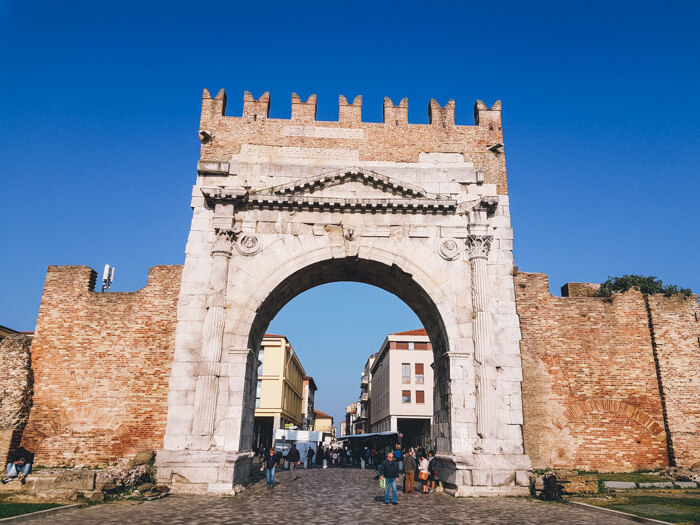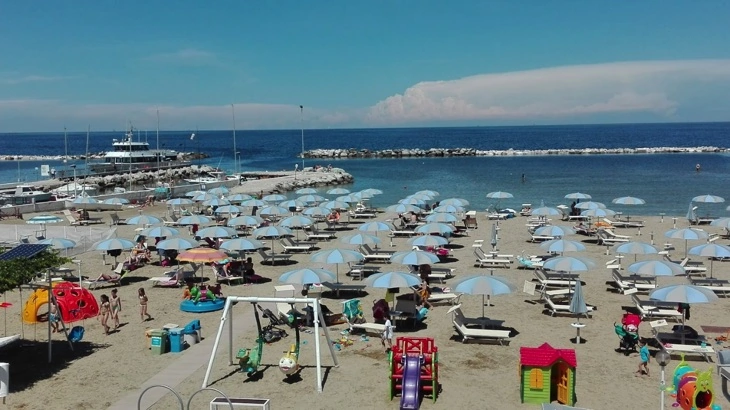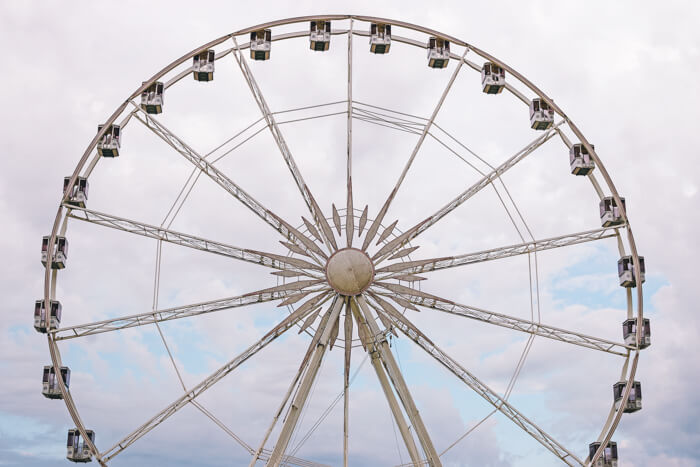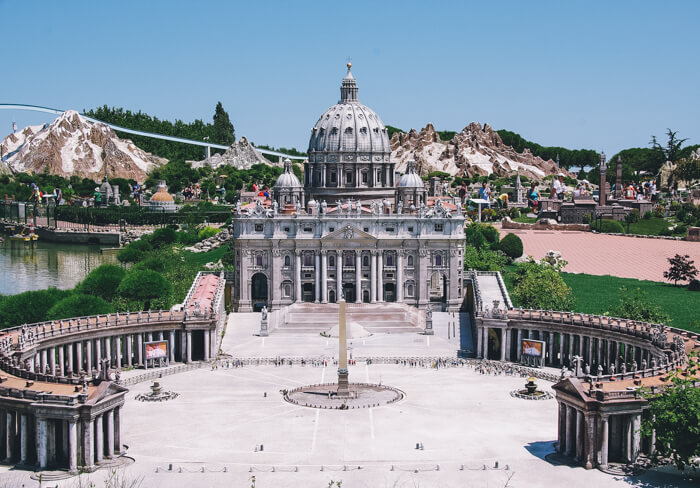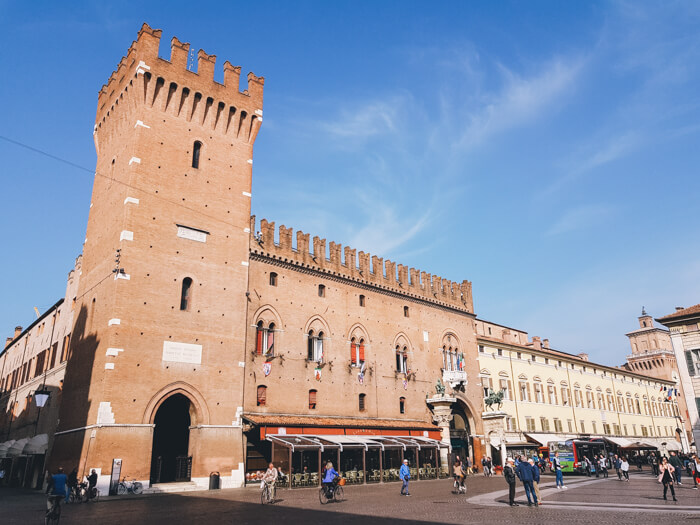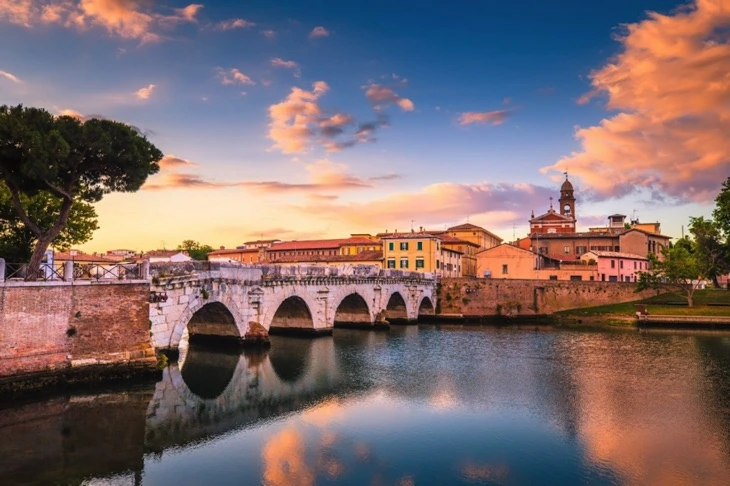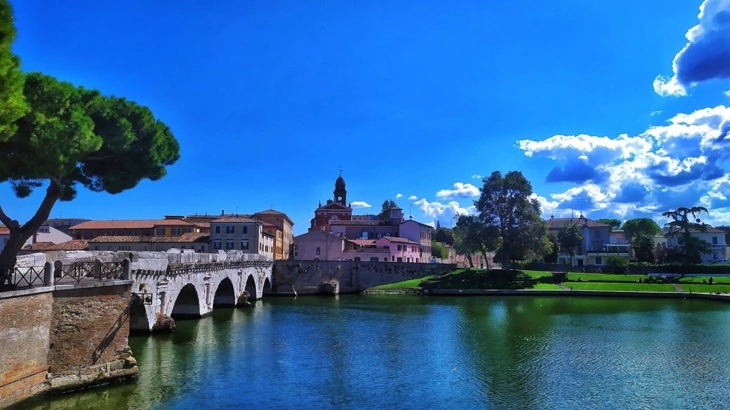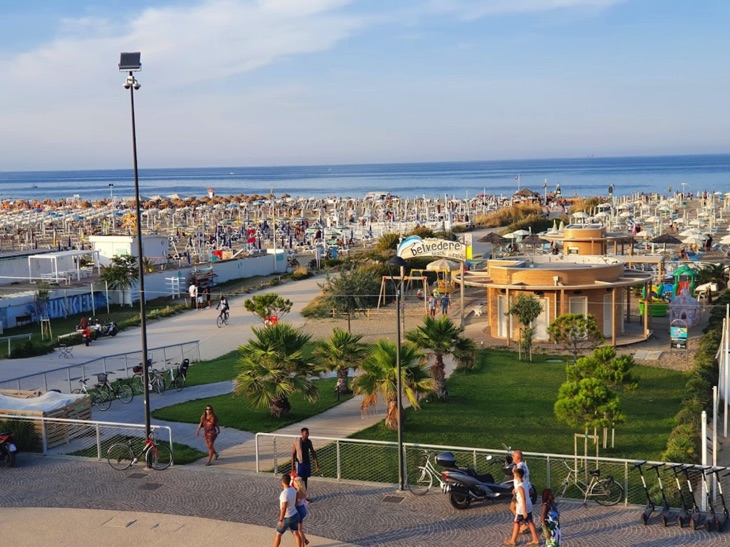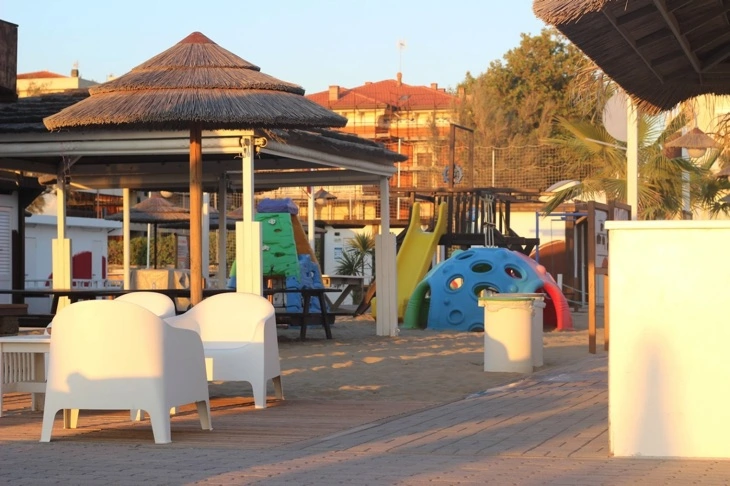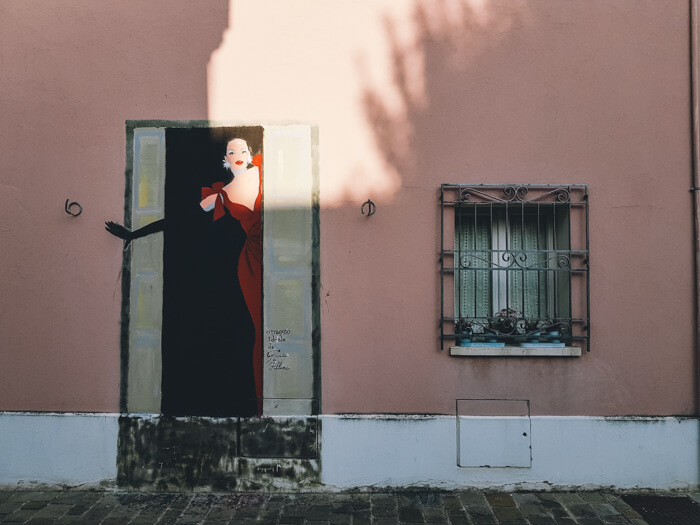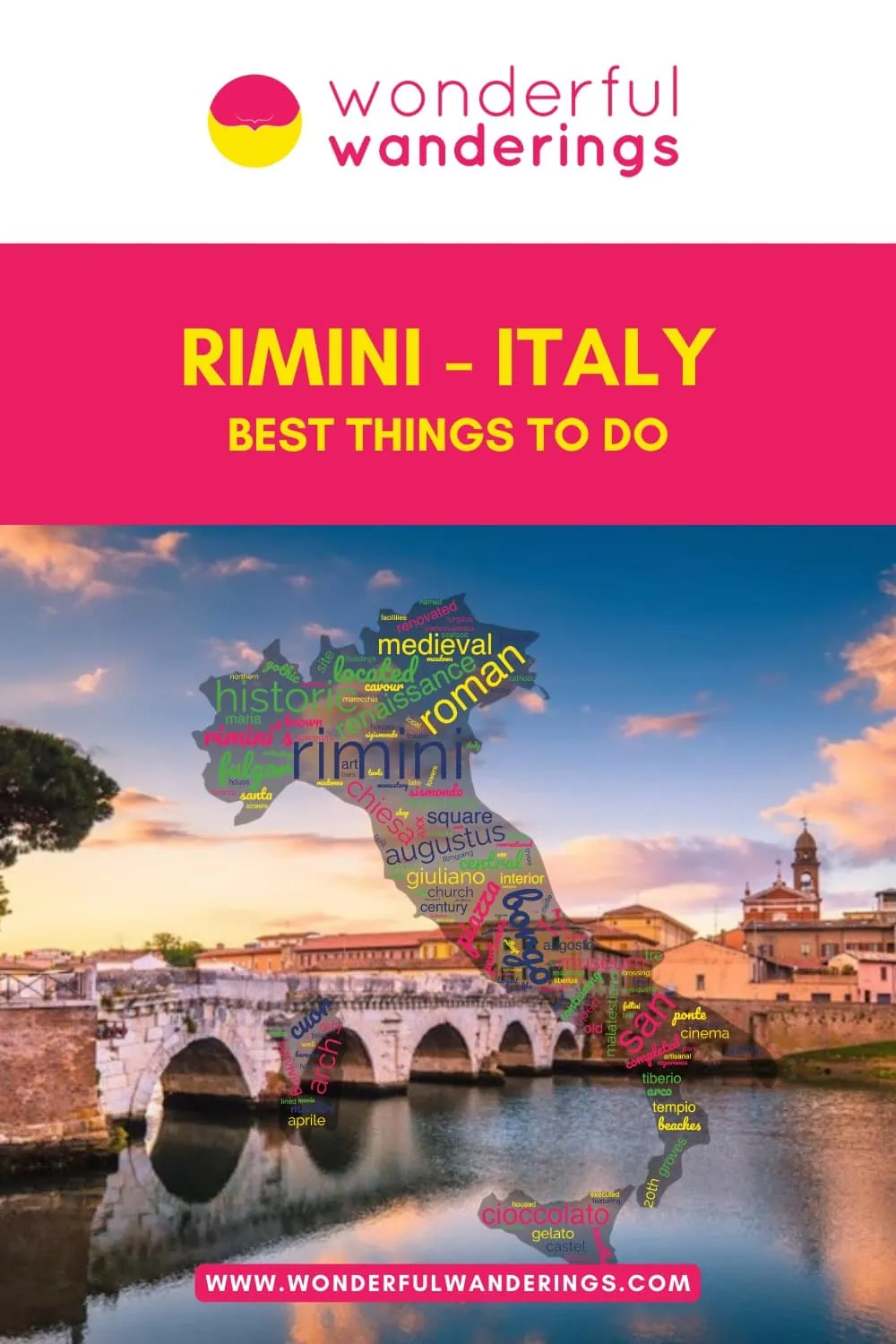Rimini is in the Emilia-Romagna region and was founded by Romans in 268 BC. It has over 15 km of beaches and is a popular seaside resort. Federico Fellini was born here, and the city is known for its nightlife and historic sites. It has monuments like the Arch of Augustus and Tiberius Bridge. The city later prospered under the Malatesta family and became a Renaissance cultural center.
Rimini is not considered expensive. It offers a budget-friendly Italian vacation experience with lower costs for accommodation, food, and transportation compared to other Italian cities. Rimini has 149,211 residents as of 2023. The average age is 48 years, and the city has a young population.
Rimini is also known for its vibrant nightlife, especially in summer. The city has numerous bars, clubs, and beach parties. Rimini has a Mediterranean climate with hot summers and mild winters. The best months to visit Rimini are May, June, and September. Rimini has a 15 km coastline with both private and public beaches. The waters are shallow and safe, making them ideal for families.
Contents
- 1. Ponte di Tiberio
- 2. Borgo San Giuliano
- 3. Parco XXV Aprile
- 4. Chiesa di Santa Maria in Corte o dei Servi
- 5. Piazza Tre Martiri
- 6. Old Cinema Fulgor
- 7. Rimini City Museum
- 8. Piazza Cavour
- 9. Castel Sismondo
- 10. Tempio Malatestiano
- 11. Cuor di Cioccolato
- 12. Arco d’ Augosto
- 13. Rimini beaches
- 14. Ruota Panoramica Ferris wheel
- 15. Italy in Miniatura
Listed below are the best things to do in Rimini.
- Ponte di Tiberio. Ponte di Tiberio is a Roman bridge built under Augustus and completed by Tiberius, still used for pedestrian crossing between Rimini’s historic center and Borgo San Giuliano.
- Borgo San Giuliano. Borgo San Giuliano is a charming medieval fisherman’s village in Rimini with colorful houses, narrow streets, and seafood restaurants.
- Parco XXV Aprile. Parco XXV Aprile is Rimini’s largest park located along the Marecchia River, featuring open meadows, groves of trees, and recreational facilities.
- Chiesa di Santa Maria. Chiesa di Santa Maria is a catholic church in Rimini known for its Baroque interior and Chapel of the Well containing a holy image of the Madonna
- Piazza Tre Martiri. Piazza Tre Martiri is a historic central square in Rimini named for three partisans executed there, located at the site of the Roman forum.
- Old Cinema Fulgor. Old Cinema Fulgor is a renovated 20th century movie theater in Rimini where Federico Fellini had his first filmgoing experience
- Rimini City Museum. Rimini City Museum is a museum housed in a former monastery displaying local archeology, art, and the surgical tools of the Surgeon’s House.
- Piazza Cavour. Piazza Cavour is another historic square in central Rimini surrounded by medieval and Renaissance buildings like the Palazzo dell’Arengo.
- Castel Sismondo. Castel Sismondo is a 15th century castle in Rimini commissioned by Sigismondo Malatesta, designed with imposing square towers
- Tempio Malatestiano. Tempio Malatestiano is a church with Renaissance facade by Alberti and elaborate late Gothic interior with artworks.
- Cuor di Cioccolato. Cuor di Cioccolato is a famous gelato shop in central Rimini known for high-quality, creatively flavored artisanal gelato.
- Arco d’ Augosto. Arco d’ Augosto is a 27 BC Roman arch in Rimini honoring Augustus, the oldest surviving arch in northern Italy.
- Rimini beaches. Sandy beaches along the Adriatic Sea in Rimini, lined with restaurants, bars, and sun loungers.
- Ruota Panoramica Ferris wheel. Ruota Panoramica is a 55 meter tall Ferris wheel on Rimini’s waterfront offering panoramic views of the coast.
- Italy in Miniatura. Italy in Miniatura is an imaginative theme park in Rimini displaying meticulously crafted miniature models of Italian landmarks.
1. Ponte di Tiberio
Ponte di Tiberio is an ancient Roman bridge located in Rimini, Italy. It spans the Marecchia River and connects the historic city center to the Borgo San Giuliano district. The bridge was started by Emperor Augustus in 14 AD and completed by Emperor Tiberius in 21 AD, which is how it got its name. The address of Ponte di Tiberio is Viale Tiberio, Rimini 47900, Italy. The bridge is also referred to as the Bridge of Augustus because construction began when Augustus reigned but was only completed when Tiberius reigned. The crossing was the only one that wasn’t destroyed in the Battle of Rimini and is still used for pedestrian and ordinary vehicle crossing – but is not suitable for trucks.
To get to Ponte di Tiberio, the nearest bus stop is Ducale, served by bus line 1. If coming from Rimini train station, walk north on Viale Dante until reaching Piazza Tre Martiri. Then take the road to the right and continue until you reach the bridge. Ponte di Tiberio can also be reached by walking or biking from many parts of central Rimini.
Ponte di Tiberio is an excellent activity for history buffs of all ages who want to see an ancient Roman bridge that is still in use after 2,000 years. Families with kids would also appreciate the history and legend behind the bridge. The bridge is located right on a bike path, so cycling across Ponte di Tiberio is also a popular activity. Photographers enjoy capturing photos of the picturesque bridge from the new Piazza sull’Acqua. Locals and tourists alike enjoy strolling across the pedestrian-only bridge and taking in views of the Borgo San Giuliano district.
Ponte di Tiberio makes for an interesting visit at any time of day, but it is particularly beautiful at sunset when its arches reflect off the water. In the evening, the bridge provides a popular gathering spot to enjoy the lively atmosphere of restaurants and cafes just across the bridge in Borgo San Giuliano. No matter what your interests, Ponte di Tiberio is a must-see attraction when visiting Rimini to appreciate its history, architecture, and scenic views.
2. Borgo San Giuliano
Borgo San Giuliano is an ancient neighborhood located in Rimini, Italy. The full address is Via San Giuliano, 47921 Rimini RN, Italy. Borgo San Giuliano started as a small fishing village around the year 1000 AD. It is located on the north bank of the Marecchia river and is connected to Rimini’s historic center by the Tiberius Bridge. To get to Borgo San Giuliano, you can walk across the Tiberius Bridge from Rimini’s city center. If driving, there are parking areas near the Tiberius Bridge and along Viale Tiberio. You may notice that many homes also have painted ceramic plaques that illustrate old boats and reveal the name of the sailor who used to own the house.
Borgo San Giuliano is a charming area to explore on foot. The narrow cobblestone streets and small squares have a medieval atmosphere. The houses are painted in pastel colors and many have murals depicting scenes from Federico Fellini films. Fellini was inspired by Borgo San Giuliano and its residents. There are also ceramic tiles on houses depicting the names and nicknames of former fishermen residents.
Borgo San Giuliano is enjoyable for people of all ages interested in art, culture, history, and good food. Families with kids can walk around looking at the murals and eating gelato. History buffs will appreciate the medieval layout and remnants of the old wall. Fellini fans can look for movie references. Foodies can try seafood restaurants and wine bars. The pedestrian-only streets make Borgo San Giuliano ideal for leisurely strolling through its picturesque alleys and small squares. Every two years in September, a lively festival called Festa de Borg takes place in Borgo San Giuliano.
3. Parco XXV Aprile
Parco XXV Aprile is a large public park located in Rimini, Italy. It is also known as Marecchia Park. The full address is Viale Tiberio, 47921 Rimini RN, Italy. Parco XXV Aprile, also known as Parco Marecchia, covers 25 hectares and sits on the former riverbed of the Marecchia River. It is Rimini’s largest civic park. The park stretches between the city’s historic center, the Ponte di Tiberio (Bridge of Tiberius), and the districts of San Giuliano, INA Casa, Marecchiese and Celle. Parco XXV Aprile contains open meadows, groves of trees, sports facilities, and playgrounds for children. The park’s tree population consists mainly of native species like poplar, willow, alder, linden and ash trees.
To get to Parco XXV Aprile, visitors can take public transportation to the nearby train station on Viale Tiberio. The park entrance sits just 350 meters from the iconic Ponte di Tiberio. Visitors can also drive and park in the public parking area next to the park. A bike path that runs through Parco XXV Aprile connects Rimini to Saiano along the Marecchia River, making the park accessible by bicycle as well.
Parco XXV Aprile appeals to a wide audience, making it a popular spot for both locals and tourists in Rimini. The park’s ample open space, playgrounds and sports facilities provide fun activities for children. Teens and adults can enjoy hiking, jogging and cycling on the park’s paths. The scenic river views and abundance of trees and green space create an atmosphere of relaxation, attracting adults and seniors who want to read, picnic, or simply sit and enjoy nature. Leashed dogs are permitted in certain areas, so the park accommodates pet owners too. With its diversity of amenities, Parco XXV Aprile offers something for visitors of all ages and interests.
4. Chiesa di Santa Maria in Corte o dei Servi
Chiesa di Santa Maria in Corte o dei Servi is a Catholic church located in Rimini, Italy. It is more commonly known as Chiesa dei Servi, referring to the Servants of Mary religious order who built the church in the 14th century. The church is located in historic city center of Rimini.
What makes Chiesa di Santa Maria in Corte special is its architecture and art. The original 14th century Gothic-style church was completely transformed in the late 18th century by the Bolognese architect Gaetano Stegani into the Baroque edifice seen today. The ornate interior has gilded stucco decorations and paintings by notable artists such as Lucio Massari, Pietro Tedeschi, and Gaetano Gandolfi. Fragments of 14th century frescoes from the school of Giotto can also be seen inside.
The main draw for visitors is the Chapel of the Well, containing a venerated image of the Madonna which miraculously emerged unscathed from a well on the church grounds in 1256. Today pilgrims can still drink water from this well for its believed healing powers. The event is memorialized in a large painting on the chapel wall depicting the Cardinal retrieving the image from the well.
Chiesa di Santa Maria in Corte is located next to Piazza Tre Martiri in the historic center of Rimini, about a 10 minute walk from the Arch of Augustus. It can be reached on foot, as the surrounding area of the old town is mainly pedestrian. There is paid street parking on the Corso d’Augusto and free parking at the Parcheggio Settebello garage just north of the city walls. The church is also a short walk from bus stops on Via Bastioni Settentrionali.
Religious pilgrims will find meaning in the Madonna del Pozzo chapel and holy water font, while art and architecture enthusiasts can admire the ornate Baroque interior. The church is open daily from 7am to 12pm and 4pm to 7pm, with extended hours on Sundays, providing ample opportunity for visitors to explore this Rimini landmark. Guided tours may also be available through the local tourist office for those seeking a deeper understanding of the church’s history and artistic treasures.
Piazza Tre Martiri is a lively public gathering place lined with cafés, shops, bars, and restaurants. Visitors of all ages can enjoy strolling through the porticoes and sitting outside at one of the many cafés. The square comes alive at night when locals and tourists fill the bars and restaurants.
5. Piazza Tre Martiri
Piazza Tre Martiri is a historic square located in the center of Rimini, Italy. The square is named in memory of three young Italian partisans who were publicly hanged there by German forces on August 16, 1944 during World War II. Mario Cappelli, Luigi Nicolò, and Adelio Pagliarani were members of an anti-fascist resistance group who were captured, tortured, and executed after an act of sabotage. Today, Piazza Tre Martiri stands as a symbol of Rimini’s liberation and resistance to fascism.
The square occupies the site of the ancient Roman forum of Ariminum, founded in 268 BCE. Located at the intersection of the cardo and decumanus maximus, two main streets in the Roman town plan, the forum was the political and commercial heart of the city. Parts of the original paving stones are visible under metal grates in the modern square. A 16th-century column with a bronze statue honoring Julius Caesar marks the place where he is said to have addressed his legions after crossing the Rubicon river nearby.
Piazza Tre Martiri is situated in central Rimini, about a 10-minute walk from the Rimini train station. It can be reached by local buses 1, 2, 14, and 15 which stop at the Alberti bus stop about 150 meters from the square. Limited street parking is available, but the nearest parking garages are under Piazza Malatesta and Largo Gramsci. The square is open 24 hours a day for visitors.
6. Old Cinema Fulgor
The old Cinema Fulgor was a historic movie theater located in Rimini, Italy at Corso d’Augusto 162. It first opened in 1914 and was renowned for being the childhood movie theater of famous Italian film director Federico Fellini. The old Cinema Fulgor was special because it was where Fellini saw his very first film Maciste in Hell in around 1926 while sitting on his father’s lap. This experience had a huge impact on Fellini and inspired his lifelong love of cinema. The old theater is featured in Fellini’s classic 1973 film Amarcord, which is loosely based on his memories of growing up in Rimini.
In the decades after Fellini’s childhood, the old Cinema Fulgor remained a cornerstone of Rimini’s cultural scene. It was owned and operated by the same family from its opening until 1980. Over the years, the theater became worn down but it remained open until 2009. After closing, the iconic old Cinema Fulgor underwent a major 5-year renovation led by architect Annio Maria Matteini. The historic movie palace had its interior redesigned by Oscar-winning production designer Dante Ferretti, who was a collaborator of Fellini’s on six of his films. Ferretti aimed to recreate the magical atmosphere of 1930s and 40s Hollywood that Fellini loved. The restored old Cinema Fulgor reopened in January 2018 on what would have been Fellini’s 98th birthday.
Today, visitors can still experience films in the same space where Fellini had his life-changing first moviegoing experience over 90 years ago. The main screening room in the renovated old Cinema Fulgor retains many of the original early 20th century architectural details. The theater also houses exhibits related to Fellini’s films and legacy. Going to see a movie at the old Cinema Fulgor offers a uniquely immersive way to get to know one of Italy’s greatest creative minds. The old theater can transport viewers back to the origins of Fellini’s imaginative cinematic world. Film buffs, Fellini fans, and anyone interested in Rimini’s culture will find a trip to the historic old Cinema Fulgor worthwhile.
7. Rimini City Museum
Rimini City Museum is located in the city of Rimini, Italy. The museum is housed in a former 18th century Jesuit monastery and hospital near Piazza Ferrari. Special features of the Rimini City Museum include its Roman Lapidary containing inscriptions dating back 2000 years, and the archaeological remains of the “Surgeon’s House” which were discovered nearby during excavations in 1989. The Surgeon’s House includes well-preserved mosaics and a collection of over 150 Roman surgical instruments, giving insight into Rimini during the 2nd century AD.
The museum’s collection spans prehistory to modern times with over 1500 works of art and artifacts displayed across 40 themed galleries occupying 3000 square meters. Key highlights are the municipal art gallery with Renaissance paintings and frescoes showcasing Rimini’s cultural development. There is also a fashion design section dedicated to local 20th century designer René Gruau. The City Museum additionally houses some of filmmaker Federico Fellini’s sketches and drawings in its collection.
The archaeological division continues on the ground floor, which shows Imperial Rimini between the 2nd – 3rd-centuries. You’ll get to appreciate coins, glass, decorations, bronzes, and the surgical instrument equipment from the “Domus del Chirurgo” in Piazza Ferrari.
The Pinacoteca picture gallery is found on the first and second floors. It showcases art until the 19OOs, including that of the 14th-century Rimini school. Wood paintings, ceramics, and beautiful frescoes (including a 14th-century fresco “the Last Judgement”,) are displayed in the conference room.
The medieval section holds over 300 pieces varied between sculptures, old manuscripts, and 14th-century fine art. On the second floor, you’ll discover locally made relics by the likes of Guido Cagnacci, Simone Cantarini, Giovan Battista Costa and Il Guercino.
The Rimini City Museum is located at Via Luigi Tonini 1, 47921 Rimini RN, Italy. The museum can be easily accessed on foot from Rimini’s city center and train station, about a 10-15 minute walk away. Rimini’s Federico Fellini Airport is a short 15 minute drive. The museum appeals to both locals and tourists interested in the art, history and archaeology of Rimini and the surrounding region. Families and students would appreciate the informative exhibits portraying various periods of Rimini’s past. Admission prices are approximately $8 for adults, with discounts for senior citizens and youth.
Getting to Rimini City Museum is convenient by walking, driving, bus, or train. Visitors coming by car can find parking in the nearby Piazza Malatesta. The museum is also accessible by city bus, with the Piazza Ferrari stop located right outside. Rimini’s central train station is under 15 minutes on foot. Bicycles are available to rent for touring Rimini’s sights including the City Museum.
8. Piazza Cavour
Piazza Cavour is the second main town square in Rimini. Its stunning architecture and local markets are easily reached by a 5 minutes’ walk from the Martiri Square and a short distance from Museo della Citta. Piazza Cavour is a historic public square located in the center of Rimini, Italy. The square dates back to ancient Roman times, when it was the site of the second Roman forum of Rimini. Over the centuries, Piazza Cavour has been the political and commercial heart of the city. Today, it remains one of Rimini’s most important public gathering places.
The Piazza Cavour is known for its historic medieval and Renaissance-era buildings that line three sides of the square. The Palazzo dell’Arengo, built in 1204, was once home to Rimini’s city council. Next to it stands the Gothic Palazzo del Podestà, residence of Rimini’s chief magistrate, erected in 1334. On the west side is the neoclassical Teatro Amintore Galli theater, inaugurated in 1857. In the center of the Piazza Cavour are a 1614 statue of Pope Paul V and the Fontana della Pigna, a fountain dating to 1543 that was admired by Leonardo da Vinci.
The Piazza Cavour can be reached by public transportation or private car. The nearest bus stop is Duomo, about a 5 minute walk from the square. By car, it’s about a 10 minute drive north from Rimini railway station. Limited street parking is available around the square. The Piazza Cavour is best suited for adults interested in history, architecture, and culture. The square offers the opportunity to admire medieval and Renaissance buildings and monuments up close. Visitors can also relax at one of the cafés lining the square while taking in the atmosphere of this historic public space.
9. Castel Sismondo
Castel Sismondo is a 15th-century castle and fortress located in Rimini, Italy. The castle was commissioned by Sigismondo Pandolfo Malatesta, lord of Rimini from 1432 to 1468, and designed with the help of renowned architect Filippo Brunelleschi. Construction on Castel Sismondo began in 1437 and was completed in the mid-1440s. The castle was built to be both a lavish residence and a defensive stronghold.
What makes Castel Sismondo special is its history and architecture. It was an important seat of power for the Malatesta family and helped them exert control over Rimini. The castle has imposing square towers, thick sloping walls, and once had a deep dry moat surrounding it. The striking red and white facade features architectural elements mixing Gothic and early Renaissance styles. Inside, the rooms were sumptuously decorated to receive guests and show off the family’s wealth. Over the centuries, Castel Sismondo lost most of its fortifications but the remaining central part still shows its former grandeur.
Castel Sismondo is located right in the heart of the historic center of Rimini, an Adriatic coastal city in northeastern Italy. The full address is Piazza Malatesta, Rimini 47923, Italy. The castle is just steps away from Rimini’s main square, Piazza Cavour, and sits opposite the city’s cathedral. It is also walking distance from Rimini’s train station.
To reach Castel Sismondo, visitors can take the train to Rimini Station and walk about 10 minutes to Piazza Cavour, then continue on another couple minutes until reaching Piazza Malatesta and the castle. Driving into central Rimini, parking lots can be found near Piazza Cavour. Local buses also stop right in Piazza Malatesta. The castle makes for an interesting visit for people of all ages interested in history, architecture, and art. Kids may especially enjoy exploring the imposing historic towers and walls. Guided tours are available allowing visitors to fully take in the significance of this remarkable Renaissance castle.
10. Tempio Malatestiano
The Tempio Malatestiano is a Renaissance church located in Rimini, Italy at Via IV Novembre 35. Considered one of the most important monuments in Rimini, the Tempio Malatestiano was originally a 13th century Gothic church dedicated to St. Francis which was redesigned in the 15th century by architect Leon Battista Alberti for Sigismondo Pandolfo Malatesta, Lord of Rimini. Alberti gave the facade a neoclassical look reminiscent of a Roman triumphal arch, drawing inspiration from the nearby Arch of Augustus. The Tempio Malatestiano is renowned for its harmonious exterior contrasts with the elegant Gothic interior designed by Matteo de’ Pasti, which houses artworks by Piero della Francesca, Giotto, and Agostino di Duccio.
Two key features make the Tempio Malatestiano unique. The first is the facade designed by Alberti, made of Istrian stone. It has an unfinished upper section but the lower part shows Alberti’s classicism with its tripartite division, Corinthian semi-columns, and central portal decorated with polychrome marble panels. The second is the church’s interior which has one wide nave flanked by six side chapels elaborately decorated in the late Gothic style. Especially notable chapels include the Planets Chapel with its medieval zodiac motifs, and the Chapel of the Ancestors which holds the Tomb of the Ancestors and Descendants sculpted by Agostino di Duccio as a monument to Sigismondo’s family.
The Tempio Malatestiano is located right in the historic center of Rimini, an easy walk from the central Piazza Tre Martiri and train station. Visitors can take the local Metromare bus to the Tempio Malatestiano stop. The facade of the church faces a piazza, providing an unobstructed view. The Tempio Malatestiano is open daily except Sunday afternoon. Admission is free, making it a top choice for art lovers interested in Renaissance architecture and sculpture. Kids may especially enjoy spotting the elephant symbols of the Malatesta family throughout the chapels. With its striking facade and elaborate Gothic details, the Tempio Malatestiano offers a unique look at Early Renaissance church design.
11. Cuor di Cioccolato
Cuor di Cioccolato is a creative gelato shop located in the historic center of Rimini, Italy. What makes Cuor di Cioccolato special is its high-quality artisanal gelato made with the finest ingredients. The shop offers unique and creative flavors like chocolate ginger, chocolate with Modica chocolate crumbs, and pistachio from Bronte, Sicily. Cuor di Cioccolato is located at Via Circonvallazione Meridionale 1/3 in Rimini.
To get to the gelato shop, it is about a 10 minute walk from Rimini Railway Station. Alternatively, you can take city bus line 9 from Rimini Railway Station and get off at the Domus del Chirurgo stop, which is a 2 minute walk to Cuor di Cioccolato. The gelato shop is best suited for both adults and families with kids who want to experience authentic Italian gelato in a charming setting.
Reviewers praise the generous portions, reasonable prices, and excellent quality at Cuor di Cioccolato. The friendly staff expertly craft the gelato fresh daily. Customers can choose from typical flavors like pistachio and hazelnut along with rotating seasonal options. In addition to gelato, Cuor di Cioccolato serves delicious Italian coffee drinks, milkshakes, crepes, and affogatos. The atmosphere is elegant yet informal, complemented by the shop’s warm lighting and displays of cakes. The central Rimini gelato shop satisfies cravings in a cozy setting, ideal for savoring uniquely flavored scoops alone or with family and friends.
12. Arco d’ Augosto
Arco d’Augusto is an ancient Roman arch located in Rimini, Italy. It was built in 27 BC to honor Emperor Augustus for his restoration of the Via Flaminia road that connected Rome to Rimini. The arch marks the end point of the Via Flaminia and the beginning of the Via Emilia road.
Arco d’Augusto is the oldest surviving Roman arch in northern Italy. The arch has a single arched opening that is almost 9 meters wide, which is unusually large for an archway. The grand scale and lack of doors reflects the Pax Romana period of peace and stability under Augustus when fortified town gates were no longer necessary. The arch is decorated with Corinthian columns, ornate moldings, and carved reliefs depicting Roman gods like Jupiter, Neptune, Apollo, and Minerva. These carvings symbolize the greatness of Rome and the power of Emperor Augustus.
The address for Arco d’Augusto is Corso d’Augusto, Rimini 47921, Italy. It is located right in the historic center of Rimini, at the intersection of Via XX Settembre and Corso d’Augusto. Rimini is a seaside town on the Adriatic coast about 100 miles southeast of Bologna.
Visitors can easily reach Arco d’Augusto on foot if staying in central Rimini. It’s about a 10 minute walk from the Rimini train station. For those arriving by car, there is street parking available on Via Bastioni Meridionali about 500 meters away. Rimini is also very bike friendly, with a bike path leading from Piazza Kennedy directly to the arch.
Arco d’Augusto appeals to history buffs interested in ancient Roman architecture and art. Families would also enjoy a quick stop to see the arch and take photos. A visit is suitable for all ages, though small children might get bored since you can only look at the exterior. For a more in-depth experience, visitors can book a guided tour through the Rimini tourism office located right next to the arch.
13. Rimini beaches
One of those typical Rimini activities for visitors and locals alike is to head to the beach. Rimini beaches starts at the Federico Fellini Park and stretches for miles. Here, you get to experience beach bars, restaurants, hotels, and large areas covered with sun loungers.
Some of the popular beaches are Beach Village, Bagno 38 Egisto, Spiaggia Libera, Bagni Ricci, and the Women’s Beach.
14. Ruota Panoramica Ferris wheel
The Ruota Panoramica is a popular Ferris wheel located in Rimini, Italy. It is located along the city’s picturesque waterfront, next to the Rimini Marina Centro. The giant wheel offers breathtaking 360-degree panoramic views of the Adriatic coastline from its peak height of 55 meters (180 ft).
What makes the Ruota Panoramica special is its imposing size and prime beachfront location. Rimini’s Ferris wheel is one of the tallest in Italy and dwarfs regular amusement park rides. Its unique position next to the sea provides stunning vistas of the golden beaches, azure waters and lively promenade. The wheel’s fully enclosed, air-conditioned cabins ensure a comfortable experience for up to 168 riders at a time as it slowly rotates.
The Ferris wheel is located at Piazzale Boscovich, close to the city center and seafront hotels. The address is Largo Ruggero Boscovich, 47921 Rimini RN, Italy. Visitors can easily walk or take local buses to reach the site.
The Ruota Panoramica is suitable for people of all ages, including families with children. The leisurely ride showcases Rimini’s seaside attractions and offers lovely sunset views. It remains open daily from April through September. Tickets cost around €10 for adults and €5-7 for kids under 10.
The iconic Ferris wheel lets visitors see Rimini from a unique aerial perspective. Its beachfront location and sweeping coastal views make it a must-visit attraction.
15. Italy in Miniatura
Italy in Miniatura is an imaginative theme park located in Viserba, a district of the city of Rimini on Italy’s Adriatic coast. This one-of-a-kind attraction features over 270 scale models of famous Italian and European landmarks and monuments, allowing visitors to explore the wonders of Italy and beyond in miniature form.
What makes Italy in Miniatura truly special is the meticulous attention to detail in the creation of the scale models. Skilled artisans carefully craft each model to precisely reflect the architecture, design, and character of the original structure. Visitors can stroll through the expansive 85,000 square meter park and take in faithful renditions of architectural marvels like the Colosseum, Leaning Tower of Pisa, and St. Mark’s Basilica. The miniature city of Venice is particularly impressive, with its Canal Grande and signature gondolas.
The park is surrounded by over 10,000 plants and miniature trees and uses 66,1000 gal/ 2,500 m³ of water to fill the water basins. You can see the Grand Canal of Venice with replicas of 119 buildings, St. Mark’s Square Campanile, and the Castel Sismondo. Replays of water cannon battles between the Montefeltro and Malatesta families are set out.
Italy in Miniatura is located at Via Popilia 239 in the district of Viserba in Rimini. Rimini is a seaside city on the northeastern coast of Italy, situated along the Adriatic Sea. The park is approximately 5 kilometers north of central Rimini and can be easily reached by car via Highway A14. Visitors arriving by train can take bus number 8 from the Rimini train station directly to the park.
Kids can take lessons at the interactive driving school, battle with water cannons at a miniature castle, and ride through the story of Pinocchio. A monorail provides an aerial view of the miniatures, while simulation rides like the Canoe water coaster provide thrills. The Luna Park della Scienza gives future scientists hands-on physics experiments. Italy in Miniatura offers activities for all ages which makes it ideal for an engaging and educational family day out.
The meticulous models paired with amusement rides make Italy in Miniatura a one-of-a-kind theme park perfect for families, architecture buffs, miniatures enthusiasts, and anyone seeking an only-in-Italy experience. This hidden gem has delighted visitors for over 50 years by shrinking down the country’s most famous landmarks into an imaginative park that kids and adults will adore.
What are the best things to do in Rimini with kids?
Rimini offers many fun activities and attractions for kids and families. Listed below are the top kid-friendly things to do in Rimini:
- Italia in Miniatura: This miniature park contains over 200 small replicas of famous Italian landmarks like the Colosseum and Leaning Tower of Pisa. Kids love exploring the tiny structures.
- Fiabilandia: This charming fairy tale theme park is tailored for younger kids. It has storybook rides, shows, and a magical village.
- Aquafan: One of Europe’s largest water parks, Aquafan has exhilarating slides, rides, and pools for cooling off on hot days.
- Oltremare: At this interactive park, kids can see dolphins, birds, reptiles, and more up close. There are shows and hands-on learning.
- Beaches: Rimini’s beaches have shallow waters perfect for swimming and playing. Many have playgrounds, games, and activities.
- Fellini Museum: Older kids interested in film may enjoy exhibits about Federico Fellini, Rimini’s famous director.
- Boat trips: Fun family excursions depart from Rimini’s piers for cruising along the coast.
- Rimini adventure parks: Parks like Skypark and San Marino Adventures offer ropes courses and climbing for active kids.
Where is Rimini located?
Rimini is located along the Adriatic coast in the Emilia-Romagna region of northeastern Italy. Specifically, it is located in the province of Rimini, nestled between the rivers Marecchia and Ausa. Rimini is 124 km northeast of Bologna, which is the regional capital. The drive from Rimini to Bologna takes approximately 1 hour 45 minutes. San Marino, an independent state, lies just 24 km southwest of Rimini – only a 30 minute drive away. Major Italian cities like Florence, Venice and Rome are 2-4 hours from Rimini by car.
Rimini is an easily accessible beach destination. Its central position near both major cities and coastal villages gives visitors ample choices for side trips up and down the Adriatic shore.
What is the history of Rimini?
Rimini has ancient origins, founded in 268 BC by the Romans who built it up as a key communication and trade hub between northern and southern Italy. Several major Roman roads converged in Rimini, including the Via Flaminia, Via Aemilia, and Via Popilia. The Romans erected impressive monuments like the Arch of Augustus and the Tiberius Bridge to mark the beginning and ending of Rimini’s Decumanus.
After the fall of Rome, Rimini underwent political unrest and was ruled by various forces like the Goths, Byzantines, and the Papacy. From the 13th-14th centuries, the city prospered under the Malatesta family. Lord Sigismondo Pandolfo Malatesta transformed Rimini into a Renaissance cultural center, commissioning the Tempio Malatestiano cathedral designed by Alberti.
The Malatesta family ruled until the 16th century when Rimini passed to the Papal States. It later joined the Kingdom of Italy in the 19th century. Rimini emerged as a seaside resort starting in 1843 with the opening of its first bathing establishment. Tourism boomed after World War II.
Rimini suffered damage in World War II bombings but was liberated in 1944. The city has since rebuilt and is now one of Italy’s top beach destinations. It retains an important architectural and cultural heritage spanning ancient Roman to Renaissance times. Rimini is also the birthplace of famous film director Federico Fellini.
What’s Rimini famous for?
Rimini is considered one the most popular seaside resorts in Italy. In fact, Rimini is famous for its the beaches, the nightlife, the historic sites and Federico Fellini.
Firstly, the beaches of Rimini are over 15 km (8 miles) along the coastline. During summer, Rimini’s beaches are packed with sunbathers and beachgoers. Rimini beaches are very lively with beach clubs, bars, and restaurants. Rimini’s beaches are a major tourist draw.
Secondly the Nightlife of Rimini has a reputation to be very lively. The city has hundreds of bars, pubs, and nightclubs that stay open late into the night during summer. Rimini’s nightlife scene centers around the Marina Centro district. Young people flock to Rimini’s clubs to dance the night away.
Thirdly, Rimini has several historic sites and monuments that attract tourists. The Arch of Augustus, erected in 27 BC, still stands in Rimini’s city center. Rimini’s Roman amphitheater from the 2nd century AD hosts concerts and events. The Malatesta Temple from the 15th century mixes Gothic and Renaissance styles. Rimini also has medieval castles like the Castle of Sigismondo Malatesta.
Lastly, Rimini was the birthplace of the famous Italian film director Federico Fellini in 1920. Fellini’s movies often referenced and were inspired by his childhood in Rimini. Today there is a museum in Rimini dedicated to Fellini’s films and legacy. Fellini helped put Rimini on the map.
Is it worth visiting to Rimini?
Yes, Rimini is definitely worth visiting. Rimini has historic landmarks like the Arch of Augustus and Tiberius Bridge. Rimini also has the charming fishing village Borgo San Giuliano with colorful murals depicting Federico Fellini film scenes. In addition, Rimini is famous for its expansive sandy beaches that draw big crowds in summer. While often associated with lively nightlife and beach parties, Rimini also offers cultural attractions. The Malatesta Temple and Old Cinema Fulgor showcase Rimini’s art and architecture over the centuries. Rimini’s combination of history, art, beaches and atmosphere has plenty to offer to visitors interested in more than just the beaches.
Is Rimini expensive?
Rimini is not considered an expensive destination. The cost of living and prices for things like accommodation, food, and transportation are lower compared to many other cities in Italy and Europe. The overall day-to-day costs are quite budget-friendly for visitors. It provides an Italian vacation experience at a relatively low price point.
Grocery prices in Rimini are generally lower than in the United States. Milk costs around 1.10 EUR per liter, eggs are around 2.70 EUR per dozen, and chicken breast is about 9.50 EUR per kg. Transportation costs in Rimini are relatively affordable. The city has an extensive bus system, with a single ticket costing 1.50 EUR. Taxis start at around 4.80 EUR plus 1.30 EUR per km. A typical dinner for two at a mid-range restaurant in Rimini costs approximately 60 EUR, including appetizers, main courses, wine and dessert. More upscale restaurants can cost over 100 EUR. The average price per night for a 3-star hotel in Rimini is around 75 EUR. More budget-friendly 1-2 star hotels average around 42 EUR per night. The cost of petrol in Rimini is approximately 1.90 EUR per liter. This equals around $7.20 USD per gallon.
Is Rimini good for nightlife?
Yes, Rimini is well-known as one of the top nightlife destinations in Italy, especially during the summer tourist season. Rimini’s location along the Adriatic coastline transforms it into an entertainment hub from June through August. Rimini draws partygoers from across Europe who flock to its seaside discos, beach clubs, pool parties, music festivals, and lively bars and pubs that stay open into the early morning hours.
During the peak summer months, Rimini’s nightlife centers around the beaches and beach clubs. But the fun extends into the early fall with events like the Notte Rosa festival in July, featuring concerts, performances and parties all along the Riviera Romagnola coastline. For those craving a more underground scene, venues like Altromondo Studios and Classic Club are known for techno and house music events.
While the beaches may be the main nightlife magnet during Rimini’s lively summer season, the city’s historic center also provides a wealth of lively bars and pubs for a fun night out. The trendy San Giuliano district offers wine bars, pubs and small eateries that are packed with locals and visitors alike. Night owls can bar-hop around the atmospheric cobblestone squares until the wee hours.
What is the weather like in Rimini?
Rimini has a Mediterranean climate with mild, wet winters but hot and dry summers. Winters in Rimini are cool with average temperatures around 8°C (46°F) in January, the coldest month. Summers are very warm, with July and August being the hottest months, reaching average highs of 28°C (83°F). Spring and fall are mild and pleasant. Rimini gets significant rainfall, averaging about 28 inches per year. November is the wettest month, seeing about 2.8 inches of precipitation. July is the driest month, with only 1.2 inches of rain. Even during the driest months, Rimini can still see some rainfall.
The best months to visit Rimini for ideal weather conditions are May, June and September. In May, high temperatures reach around 22°C (71°F) with 7 hours of sunshine and low chances of rain. June brings highs of 26°C (79°F), over 15 hours of daylight, and low rainfall. September still sees warm high temperatures around 24°C (76°F) along with 12.5 hours of sunshine and low precipitation.
July is the warmest month for Rimini, when daily high temperatures reach 28°C (83°F) on average. This is the peak of summer, bringing lots of sunshine but also higher chances of rain compared to other summer months. At the other extreme, January is the coldest month with average highs of only 8°C (46°F) and overnight lows dropping to around 1°C (33°F). This mid-winter month tends to be cloudier as well.
What are the best beaches in Rimini?
The beaches in Rimini stretch along the coastline for 15 km from north to south. Most of the beaches are occupied by private beach establishments that rent out sunbeds, umbrellas, and offer amenities like showers, changing rooms, restaurants, and bars. There are also some public beaches that are free to access. The northern beaches of Rimini have breakwaters that protect the coastline from erosion but make the waters calmer. The southern beaches do not have breakwaters and can have seaweed washed up from the tides. The waters are shallower near the beach, making them good for families with children. The beaches are safe with lifeguard stations every 150 meters. There are also flags to indicate weather and sea conditions – white means calm, yellow means potential winds, and red means swimming is dangerous. The beaches are busiest from June through September and beaches offer amenities like restaurants, bars, sports equipment rentals, lounge chair rentals and water sport activities.
Listed below are the best beaches in Rimini.
- Bagno Egisto 38. Bagno Egisto 38 is a long sandy beach that is good for families. It has activities for kids like creative workshops, mini clubs, playgrounds, and parties. The waters are calm and shallow. There are amenities like a microwave, baby facilities, and hot showers. A popular family-friendly beach.
- Bagno Libra. Bagno Libra is very long, wide beach with fine golden sands. Good for groups and families. There is a bar for drinks, a mini kids club with activities, and the calm, shallow waters are good for swimming. It is a spacious and popular beach.
- Bagno Tiki 26. Bagno Tiki 26 is also a very large and spacious sandy beach that stays uncrowded due to its size. Warm soft sands and fantastic waters make it great for swimming and walking. There is a restaurant on site and the beach is popular with locals and tourists.
- Le Spiagge. Le Spiagge is Formed by combining 14 different beach establishments, this very long golden sandy beach has comprehensive amenities like lifeguards, sports areas, surfing clubs, and entertainment. Good for families or groups looking for an all-inclusive beach experience.
- Bagno 124 Mario e Luca. Bagno 124 Mario e Luca is a well maintained beach popular with locals for its friendly owners, bar, and majestic ocean views. Provides individual lockers for belongings during swims. A happening local favorite beach.
- Bagno 81 No Problem. Bagno 81 No Problem is a fun, pet-friendly beach with a restaurant and bar nearby. Shallow calm waters are good for swimming with friends or family. Provides a lively beach experience.
- Bagno 29 Palm Beach. Bagno 29 Palm Beach is a clean and nice local favorite for its serene vibe. Great for relaxing with rental chairs and umbrellas. Waters are ideal for swimming. A quieter spot in Rimini.
What should a tourist know before visiting Rimini?
Listed below are the most touristic facts about Rimini.
- Location: Rimini is located on the Adriatic coast in the Emilia-Romagna region of northern Italy.
- History: The city was founded in 268 BC by the Romans. Rimini’s most famous monuments are the Arch of Augustus, built in 27 BC, and the Tiberius Bridge, completed in 21 AD.
- Architecture: The Tempio Malatestiano is Rimini’s cathedral featuring Renaissance architecture and artworks by Piero della Francesca.
- Beaches: Rimini has over 15 km of sandy beaches along its coastline.
- Tourism: It is one of the most popular seaside resort towns in Italy with over 1000 hotels.
- Notable Residents: Rimini is the birthplace of famous film director Federico Fellini.
- Entertainment: The city has a historic Roman amphitheater that could seat 12,000 spectators. Rimini is known for its nightlife scene with lively bars, discos and nightclubs.
- Cuisine: Local cuisine specialities include seafood, Piadina flatbread, and Sangiovese wine.
How to get to Rimini?
The most common way to reach Rimini is by flying into one of the nearby airports combined with ground transportation. Trains provide convenient and frequent connections from around Italy. Renting a car allows easy access to Rimini and surrounding areas. There are several ways to get to Rimini:
- By plane: The closest airport is Rimini Federico Fellini International Airport, located 8 km from the city center. There are regular buses and taxis between the airport and downtown Rimini. Other options are flying into Bologna Airport, 120 km away, or Ancona Airport, 97 km away, and taking ground transportation to Rimini.
- By train: Rimini’s train station is centrally located and is served by high-speed and regional trains. Direct trains connect Rimini to major Italian cities like Rome, Milan, Venice, Florence and Bologna. Tickets can be booked online in advance.
- By bus: Long-distance buses operated by FlixBus and other companies connect Rimini to cities across Italy and Europe. The main bus stop is next to Rimini train station.
- By car: Rimini is easily accessible by car via the A14 motorway. The city is 268 km from Venice, 233 km from Florence, 124 km from Bologna and 341 km from Rome. Public parking is available but limited in the historic center.
To get around Rimini, the historic center is walkable and beaches are accessible by bike or local buses. For day trips, renting a car provides flexibility to visit nearby towns. Public transportation like trains and buses can also be used for short trips to destinations like San Marino, 30 minutes away.
How many people live in Rimini?
There are 149,211 residents in Rimini, according to the 2023 census. Among them, 49% are men and 51% are women. The average age of a Rimini resident stands at 48 years. Rimini city has a young population with 4,281 infants under the age of 4, which includes 2,075 girls and 2,204 boys. Additionally, Rimini has 4,776 kids aged between 5 to 9 years, with 2,458 boys and 2,317 girls. Children aged 10 to 14 number 5,357, comprising 2,757 boys and 2,600 girls. Teenagers, ranging from 14 to 19 years, total 5,673, with 2,918 boys and 2,754 girls. Remarkably, Rimini also boasts 48 centenarians, with 7 men and 38 women having lived for over 100 years.
What are the best hotels to stay in Rimini, Italy?
Listed below are the best hotels to stay in Rimini.
- Hotel Panama Majestic. The Panama Majestic is a 4-star hotel right on the seafront. Rimini city center is about a 20 minute walk away. The rooms are large and stylish with marble floors and air conditioning, all with free WiFi and an ensuite bathroom. It features two rooftop hot tubs, a fitness area and sauna for guests to use. There’s also a restaurant and bar area.
View on Booking.com / Read reviews on TripAdvisor - Admiral Art Hotel. This quirky Rimini hotel right next to its own private beach has an urban vibe to the decor. Each room has a unique design with a cool feature wall. It’s all air-conditioned and there’s a terrace area, restaurant bar and communal lounge complete with grand piano.
View on Booking.com / Read reviews on TripAdvisor - Best Western Maison B Hotel. Rimini’s Best Western hotel is a beachfront haven with a panoramic restaurant overlooking the waves. Free WiFi, air-conditioning, a swimming pool and private parking are just some of the great features of this classy hotel.
View on Booking.com / Read reviews on TripAdvisor - Card International Hotel. A city center option, Card International Hotel is really near both Rimini train station and Tempio Malatestiano, as well as loads of the other landmarks described above. The hotel has a 24-hour bar, sun terrace, fitness area, lounge area and you can rent bikes from the reception.
View on Booking.com / Read reviews on TripAdvisor
What are the best restaurants to eat and drink in Rimini?
Listed below are the best restaurants to eat and drink in Rimini.
- Lo Zodiaco: Lo Zodiaco is a Seafood Restaurant with fresh, high-quality seafood dishes. Dinner for two costs around €35 ($39) per person) and is until late. It is a great option for a romantic dinner or special occasion.
- Sotto Sale: Sotto Sale is a western-Style Restaurant It offers classic Italian and international dishes in a casual setting. Mains cost around €25 ($28) per person. It’s moderately priced and popular for its rustic ambiance.
- Le Milton Beach. Le Milton Beach is a beachfront restaurant along the Rimini coastline. It serves Mediterranean cuisine and specializes in seafood. It has an outdoor terrace and scenic ocean views. Le Milton Beach is a nice option for lunch or dinner.
- La Puraza: La Puraza is an upscale seafood restaurant. The meals cost around €55 ($64) per person and is considered a fine dining option. It delivers high quality seafood dishes and attentive service.
- Guido Restaurant: Guido Restaurant is fine dining restaurants with amazing views. It is known for its elegant dishes and refined seafood menu. Main dishes cost around €65 ($77). It provides an exceptional dining experience with panoramic views of the sea.
- Cucina Della Nonna: Cucina Della Nonna serves classic Italian comfort food in a cozy trattoria setting. It serves hearty pastas, pizzas and more. It offers a taste of homemade dishes at reasonable prices.
- Osteria Grotta Rossa: Osteria Grotta Rossa is a solid choice for authentic regional specialty dishes. Main courses cost around €20 ($24). Local dishes like stuffed pastas, seafood risottos and more can be enjoyed in this casual osteria.
PIN FOR LATER

